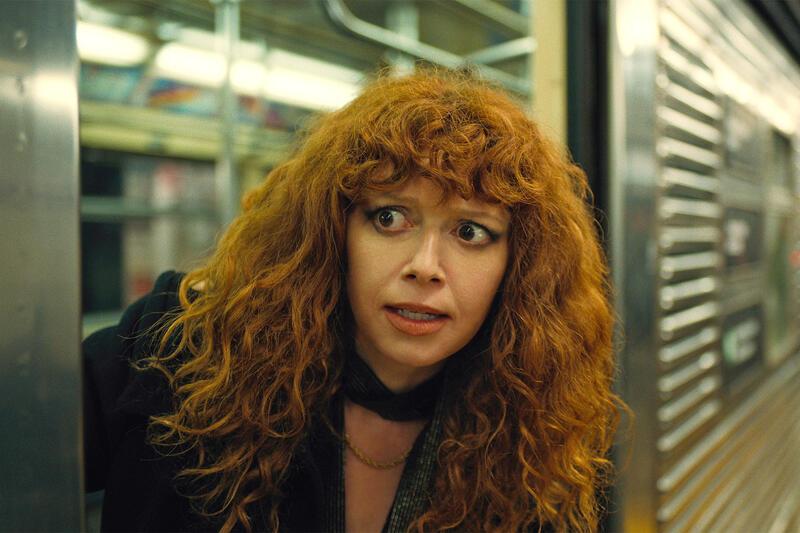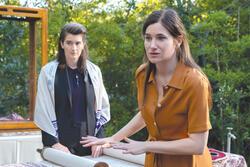"Russian Doll" Season 2: Messy, but Beautiful
Warning: Spoilers ahead!
When Russian Doll came out in 2019, publications from Rolling Stone to The New Yorker praised its macabre version of Groundhog Day. I remember binging season 1 and thinking that, where one viewing of Groundhog Day felt like 600, I could watch Natasha Lyonne, who plays the protagonist Nadia Vulvokov, over and over. Her charisma, chaotic antics, emotional depth, and in particular, her Jewishness made Nadia complex, relatable, and exciting to watch. So when season 2 finally dropped nearly three years later, I couldn’t wait to see what time-bending adventures Nadia would get up to next.
Three episodes in, with Netflix automatically cuing the next one, I found myself sitting in bed, disappointed. I thought I would soon be writing a review saying that, although season 2 of Russian Doll certainly engaged more thoroughly with Judaism than the first season, it was infinitely less satisfying.
The arc of the first season felt clean. There was a clear conflict: Unable to escape the purgatory of her 36th birthday, Nadia is forced to die over and over and end up back in her bathroom with Harry Nilsson’s “Gotta Get Up” blaring in the background. There was a clear objective: to find a way out of this death loop. And there was a clear solution: to finally free herself from the guilt surrounding the suicide of her schizophrenic mother and accept the companionship and help of Alan, who is stuck in a death loop of his own. While all of this information was delivered bit by bit, keeping viewers at the edge of their seats and retaining a sense of mystery, the plot was focused and strong.
Season 2, in contrast, started out feeling sloppy and disorganized, with competing conflicts and objectives, making it unclear to the viewer which to grasp onto and follow. We pick up four years after the first season ends, on the eve of Nadia’s 40th birthday. This time around, instead of living the same day repeatedly, when Nadia boards car 6622 of the express 6 train in New York City, she is transported back in time to live out the life of, alternately, her mother or her grandmother.
Nadia’s constantly shifting objectives are hard to follow and undermine all the work Nadia did in the first season to accept her past and her relationship with her mother. For a seven-episode season, it's too much ground to cover.
And I haven’t even mentioned the strange, seemingly irrelevant addition of Alan’s travels into his grandmother’s past in Berlin, which feel like a weak continuation of season 1’s revelation that Nadia and Alan’s experiences are linked. Unlike Nadia’s travels in the bodies of her mother and grandmother, which expanded on content from earlier in the series, Alan’s travels in his grandmother’s body ultimately add no plot-shattering insight (although they arguably queer his character, which slightly decreased my annoyance).
Despite all of this, as I reached the last two episodes of the season, my opinion shifted. Though I stand by my assertion that season 2’s plot felt a bit haphazard, its investigation of Jewish themes in combination with Nadia’s relationships with her mother and grandmother redeemed the season for me.
One of the main Jewish concepts referenced in the show, Sheol—a liminal space where humans descend after death—is introduced in the final episode. As time is upended in Nadia’s apartment, she opens the bathroom door to a classroom in the yeshiva that once occupied her building. At the front of the room stands a rabbi with a chalkboard behind him that reads “Sheol, The Great Deep.” The Rabbi lectures, “They went down, alive, into the realm of the dead…which is Sheol, where all dead go. The common grave for all humanity.”
If I learned anything from my first Feminist Media Studies class in college, it is that every minute detail in media is there for a reason. It is no coincidence that the rabbi says, “They went down, alive, into the realm of the dead,” since this is effectively what Nadia and (unimportantly) Alan have been doing this whole season. (Can you tell I’m still bitter about Alan’s plot line?) Each time they descend the stairs into the subway station, they travel into the past, visiting family members who are no longer living. The subway becomes a portal to Sheol.
According to Kabbalah, those who descend into Sheol can only emerge by doing teshuvah, a term that translates to “returning” and refers to the Jewish concept of repentance. As Nadia literally returns to the lives of her mother and grandmother, she is forced to reckon with the resentment she feels toward both women and repair those previously shattered relationships.
Which brings us to the other underlying Jewish themes of the series: the Holocaust and the transmission of trauma from Nadia’s grandmother, Vera, to her mother, Nora, and finally, to Nadia. Nadia’s travels into both women’s lives help her process this trauma.
Through Vera, Nadia is immersed in the ubiquitous culture of fear her grandmother navigated as a Jew in World War II. Losing everything pushed Vera into a scarcity mindset that Nadia had previously registered as cold and controlling. Experiencing her grandmother’s fear firsthand shifts Nadia’s perception—she now understands Vera’s behavior as her furious fight for survival.
Through Nora, Nadia sees the impact of Vera’s trauma. In her fight to survive, Vera often has rigid expectations for how her daughter should live. Nora’s paranoia and manic behavior make it difficult to meet her mother’s expectations, causing her to feel rejected and unloved. Though previously Nadia resented her mother’s mental illness and its impact on her life, with this new knowledge, she is able to contextualize Nora’s sometimes erratic behavior and empathize with her.
In living through both women, Nadia accepts their humanity. She realizes that their physical and emotional lives are just as rich as hers is and is finally able to appreciate and love these women for who they are, flaws included. In this way, her travels back in time—into Sheol—give her the opportunity to forgive the matriarchs of her life and appreciate their sacrifices.
It seems significant that season 2 was released in the middle of Passover, a holiday on which the Jewish people are commanded to retell the stories of our ancestors in order to better understand our purpose. By traveling through her ancestors’ lives, Nadia comes to appreciate how their journeys shaped who she is today.
Season 2 ends the way Season 1 began: with Nadia standing over her bathroom sink looking straight into the camera. The pained look of existential dread that opens the first season contrasts with the weary, albeit serene, expression of a Nadia who has seen a lot of shit and come out the other side, accepting her life and all the baggage that comes with it.
Despite its clunky beginnings, the final moments of season 2 are raw and poignant, and reminded me of films like Everything Everywhere All At Once, Turning Red, and Lady Bird, all of which unpack the sometimes ugly complexities of mother-daughter relationships. Though I was confused at times, the arc of Nadia’s relationship with her mother and grandmother demonstrated that same gritty-messy-multiplicitous experience of femininity that drew me in at the start of series. That, combined with the show’s poetic investigation of Jewish thought, will keep me coming back for more.







